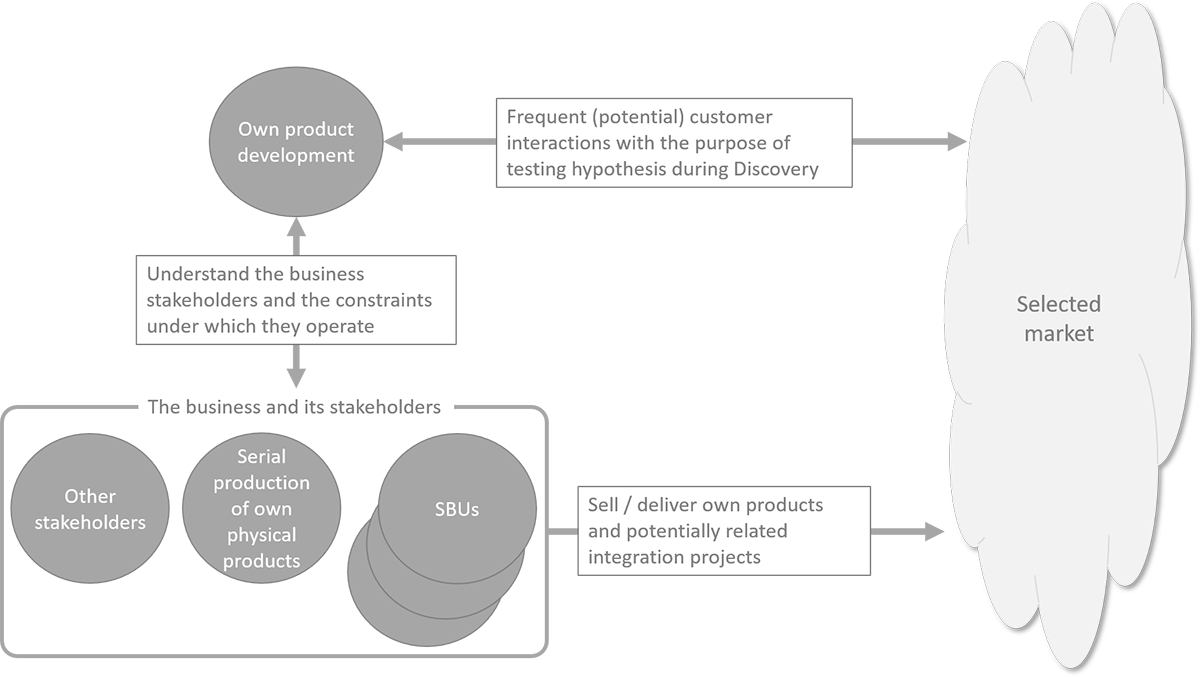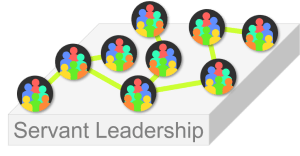This is part 2 in the series of posts discussing the journey towards becoming a strong Product company. Here we’ll focus on the Vision as formulated by RT’s executive team.
Recap from part 1
In part 1 the strategic context of the hypothetical company, Renewable Tech [RT], was outlined. From currently being a provider of customer-specific solutions, RT’s strategy is to undergo a transformation towards becoming a market-leading product company within renewables technology. Referencing Marty Cagan:
We balance four product risks in Product Discovery making sure that the product is
- valuable for the customer
- usable for the customer as intended
- feasible for us to build
- viable for our business
Marty Cagan, Silicon Valley Product Group
Note that most of RT’s (coming) products have a physical dimension, though some purely digital. Product Discovery and Delivery is not done by having a working prototype. It is done when serial production (using relevant Industry 4.0 elements) runs. As quoted earlier:
The Vision
RT’s executive team is determined to learn from and eventually become among the few best high-tech Product companies. RT has thus decided to seek guidance from SVPG – Silicon Valley Product Group – because this is what comes closest to a consolidated insight into the workings of the worlds best high-tech Product companies.
RT has found, that the overarching and common strength among these best-in-class companies is their highly developed Product Culture as described by Marty Cagan:
- Culture of experimentation
- Culture of open minds
- Culture of empowerment
- Culture of technology
- Culture of business- and customer-savvy teams
- Culture of skill-set and staff diversity
- Culture of discovery techniques
We’ll return to the Product Culture.
The corner-stone in RT’s (coming) ability to Discover and Deliver high-tech renewables products that customers love, yet work for the business, is the network of Product Teams.
Teams
As described earlier, these are the general characteristics of a Product Team:
- is stable and cross-functional
- is autonomous (though some dependencies will exist in practice)
- is self-organized
- is given a (hard) business / customer problem to solve
- is empowered to Discover the right solution to the problem
- is measured & held accountable for the Outcome (business result)
- perceives itself as a group of missionaries with a cause
Though some experiments with DevOps (you build it – you run it) on purely digital products have been run, the predominant approach to complexity in RT is currently the classic project with the classic project organization:
- is an ad-hoc allocation of people from the functional silos, thus being dissolved when the project is done
- is tasked with the development of a given and specified solution thus focusing on Output
- cannot be held responsible for the Outcome (business result) for the simple reason that the Team was given the solution to implement
- perceives itself as a group of mercenaries with specified tasks to execute
The current auto-pilot reaction to a problem in RT is thus to pull-out the known tool from the toolbox: a project. This is a sensible modus operandi when talking customer solution projects. Approaching innovation with a project mindset is highly counter productive.
RT’s executive team realizes that coming from a project mindset with ad-hoc project teams to a product mindset with stable product teams is a major challenge. But – the executive team is stubborn on the vision – it is a fundamental prerequisite for RT’s ability to become a strong Product company.
Leadership and organizational structure
The aim for RT’s executive team is to have an organization filled with and working for missionaries. To quote Gary Hamel:
Gary Hamel
The leadership / management role
RT’s executive team has reached the same conclusion as Marty Cagan:
Marty Cagan, Silicon Valley Product Group
“Better” means the ability to optimize the conditions under which the network of Product Teams operate. In essence it is about Servant Leadership being able to provide meaning, direction, (real) empowerment and support.
RT is not dismantling the functional “silo”. RT is redefining it and the leadership / management roles within it. Remember that one of the critically important responsibilities of Servant Leadership is to coach the professionals, with reference to Bill Campbell:
Bill Campbell
The leader / manager with direct responsibility for employees must have and maintain sufficient domain insight to be capable of providing coaching and helping the individuals to grow.
RT’s executive team have found Marty Cagan’s definition of the CTO, CPO and PM roles in the strong Product company to be a solid starting-point:
- Organization – building an excellent technology organization with a strong management team committed to developing the skills of your employees.
- Leadership – representing technology in the overall strategic direction and leadership of the company, working with other company executives to help inform direction, M&A activity, and build / buy / partner decisions.
- Delivery – making sure the organization can rapidly, reliably and repeatedly deliver quality product to market.
- Architecture – making sure the company has an architecture capable of delivering the functionality, scalability, reliability, security and performance it needs to compete and thrive.
- Discovery – making sure that members of the senior engineering staff are participating actively and contributing significantly throughout Product Discovery.
- Evangelism – serving as the company spokesperson for the engineering organization, demonstrating leadership in the community with developers, partners and customers.
Marty Cagan
- Team Development – developing a strong team of Product Managers and Product Designers is the single most important responsibility.
- Product Vision and Strategy – is what drives and inspires the company and sustains the company through ups and downs.
- Execution – is a matter of getting things done thus needing an expert on modern forms of product planning, customer discovery, product discovery, and product development process.
- Product Culture – in the strong sense means that the teams understand the importance of continuous and rapid testing and learning.Marty Cagan
PM – Product Manager … not to be confused with a Project Manager
- Deep knowledge of the Customer – meaning the need to become an acknowledged expert on the customer: their issues, pains, desires, how they think, how they work, and how they decide to buy. Of course the PM must also be an undisputed expert on your actual product.
- Deep knowledge of the Data – being comfortable with data and analytics.
- Deep knowledge of your Business– understanding how it works and the role your product plays in your business. This includes knowing who the various stakeholders are and especially learning the constraints they operate under.
- Deep knowledge of your Market and Industry – covering not only your competitors but also key trends in technology, customer behaviors and expectations and following the relevant industry analysts. The PM may be supplemented with what are called domain experts or subject matter experts.Marty Cagan
Team Empowerment
Highly empowered teams is not the same as the Product Teams are free to decide everything. With empowerment comes conditions agreed with leadership / management. Because RT’s business is based on applied technology, sharp strategies on technology is of vital importance.
It is a leadership responsibility (with the top-level responsibility anchored with the CTO) to maintain and communicate these technology strategies under which the Product Teams operate. It can and will happen that a Product Team discover a solution outside the perimeter of the technology strategies. In this case they’ll of course approach relevant technology leadership for a dialogue.
Organizational structure
RT’s executive team wants to boost the Product Culture with Product Teams as much as possible thereby boosting RT’s innovation power. This calls for an organizational structure with Product Teams serving the (real) customers; not serving internal stakeholders. This is the out-line structure as defined by RT’s executive team:

What is important to note here is, that the Product Teams in “Own product development” have a direct and frequent dialogue with selected (potential) customers; not via Sales / the SBUs.
This is not the same as the Product Teams act in isolation. In fact, the Product Teams (and especially the Product Manager in the team) have an obligation and interest in understanding the constraints under which the team’s business stakeholders operate. To repeat the very important point: the Product Teams serve the customers – not the business.
Product Team topology
Some of RT’s (coming) products can be held within one Product Team. Other products will need a network of Product Teams collaborating on the product. As expressed above, one of the responsibilities of Servant Leadership is to facilitate the smooth collaboration and communication in the network of Product Teams.

Exactly how a given Product Team is designed, is a leadership responsibility, derived from RT’s generic Product Team template:
- Product Manager.
Main responsibility: Solutions are valuable and viable. Includes the Scrum PO role owning the Product Backlog – but is much more! - Product Designer.
Main responsibility: Solutions are useable. - Engineers / developers.
Main responsibility: Solutions are feasible.
Tech Lead: A senior level engineer having taken additional responsibility. - Scrum Master / Delivery Manager.
Could be the Tech Lead. Some teams do not need a Scrum Master at all.
- Product Manager.
When talking products with a physical dimension, and thus production, the Product Team of course also need to have production technology competences on-board. Remember: the Product Teams have the full end-to-end product accountability.
How the intended Product Culture will support the vision .. with anti-patterns
With reference to the Product Culture outlined at the start, the intention below is to illustrate its link to the vision. You’ll also find examples of how not-to-do.
Culture of experimentation
The use of carefully designed and disciplined run experiments, testing assumptions is key to gaining new insight and learning. The principle is – fail fast, learn fast. For this to work an atmosphere of trust and psychological safety is fundamental.
Antipatterns
Failing experiments is perceived as the team is failing. This will definitively kill the teams motivation. Another efficient way to kill a culture of experimentation is to demand the use of the company’s “project model” used for customer projects.
Culture of open minds
The mindset is that we’re all innovators capable of bringing innovative ideas to the table. Having an open mind allows for normally not obvious sources to contribute.
Antipatterns
Only a selected group of people are expected / invited to contribute with the brilliant ideas.
Culture of empowerment
This is nicely captured by Gary Hamel:
Gary Hamel, Humanocracy p. 262
Antipatterns
It is just nice words on paper. In reality teams and individuals meet mistrust and a command & control mindset.
Culture of technology
With a deep and up-to-date understanding of technologies and its mega-trends comes a source of inspiration for new products not yet demanded by the customers. Apple’s iPhone is a great example.
Antipatterns
Chase what you competitors do in a never-ending catch-up game.
Culture of business- and customer-savvy teams
The full team, not “just” the PM, has a deep understanding of the customers and of the needs and constraints in the business.
Antipatterns
Team has misunderstood the notion of being “autonomous” in the sense that is does not have to care about internal or external stakeholders.
Culture of skill-set and staff diversity
This is directly linked to the culture of open minds appreciating that people with different skills and background can contribute to innovative solutions.
Antipatterns
We know best!
Culture of discovery techniques
The teams have not only one but a variety of techniques helping the teams quickly to discover the best solutions to the given problems … and do it in a way protecting RT’s brand, revenue, customers and colleagues.
Antipatterns
Make everything a project.
Wrap-up
Now having understood the targeted future situation – the vision- for RT, the next post will discuss the strategy for how to make the vision come alive.
Spoiler alert: start small.
Stay tuned!

